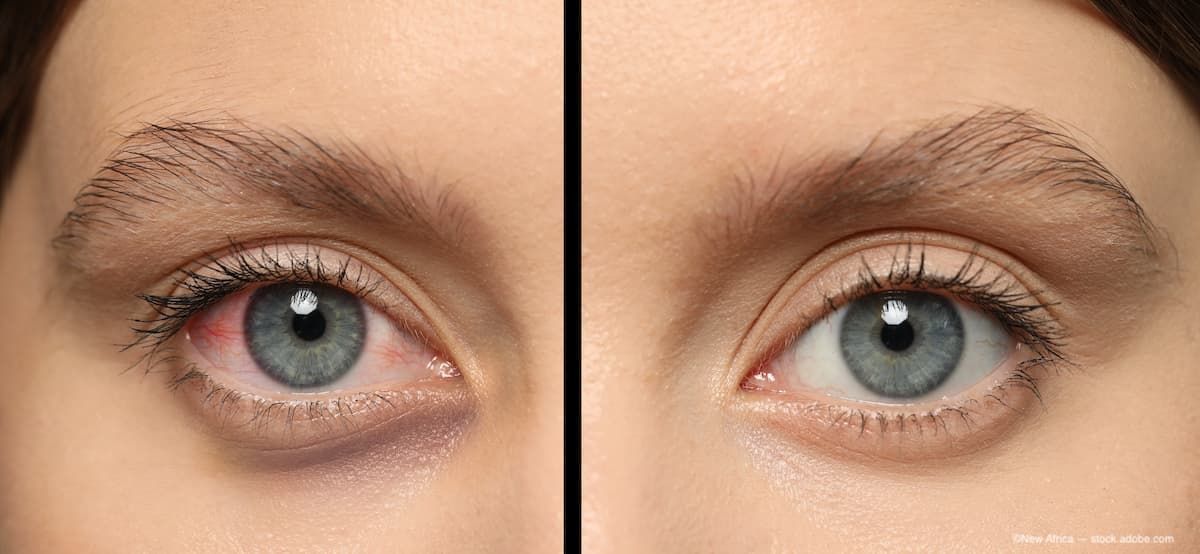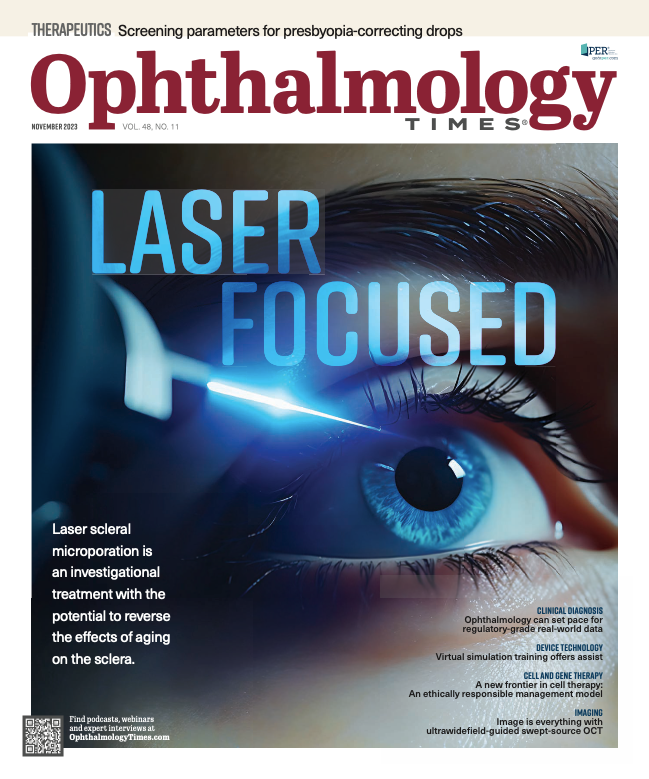Publication
Article
Digital Edition
When managing cases of dry eye, expect the unexpected
Author(s):
Slit lamp evaluation can provide valuable information for treatment course.
(Image Credit: AdobeStock/New Africa)

Reviewed by Mile Brujic, OD, FAAO
Managing patients diagnosed with dry eye disease may not be as clear-cut as it appears. Mile Brujic, OD, FAAO, a partner in the Premier Vision Group in Bowling Green, Ohio, shared his pearls with 2 challenging cases at a recent Ophthalmology Times and Optometry Times Case-Based Roundtable.
Case 1: A less-than-straightforward case
A 42-year-old woman presented for her annual ocular examination. She wears glasses with a slight myopic correction and spends 8 to 10 hours daily doing computer work. She reported increasing ocular fatigue and discomfort as the day progresses. Her medical history is unremarkable and she does not take any medications. The examination showed a normal posterior segment, but there were some concerns regarding the anterior segment. She had complete lid seal. The length of the meibomian glands were normal; however, there was mild meibomian gland dysfunction, indicating some resistance to meibum exiting the meibomian gland orifices. The bulbar conjunctiva showed mild diffuse hyperemia bilaterally, and mild sodium fluorescein and lissamine green staining was seen nasally. The palpebral conjunctiva was clear and quiet; however, the tear film breakup time (TBUT) was 2 to 3 seconds OU (normal, 10-12 seconds). Sodium fluorescein showed mild corneal staining bilaterally. The anterior chamber was clear and deep, the iris was flat and healthy, and the lens had mild nuclear changes—the last of which was unusual for a patient of her age.
Brujic emphasized the importance of the slit lamp evaluation because, despite what was thought previously, this patient had incomplete lid closure upon blinking and the TBUT was reduced dramatically.
“When a patient is considered to have dry eye disease, we always administer a Standardized Patient Evaluation of Eye Dryness [SPEED] Questionnaire, which provides an objective measurement over time of the patients’ symptoms and the treatment effectiveness," he said.
Treatment approach
Brujic discussed lid hygiene, specifically the 20-20-20 rule. This rule recommends taking a 20-second break after 20 minutes of screen time to look at something approximately
20 ft away.
This patient began topical cyclosporine drops 0.09% twice daily and preservative-free artificial tears as needed. She also began using a heat mask that provides warm, moist heat to the lid surface when the eyes are closed for approximately 5 to 10 minutes daily.
She was advised to return for a follow-up evaluation 8 weeks later but did not return for 1 year. At that time, she had discontinued cyclosporine and was no longer using artificial tears or the heat mask. The examination showed the same anterior segment findings as previously. Her reasoning for nonadherence was an inability to instill drops. She currently is using a high-quality nutraceutical with at least 1000 mg of ωw3.
When Brujic discussed use of a nasal spray (varenicline solution; Tyrvaya; Viatris) twice daily and pharmaceutically enhancing how eyes produce tears without having to instill drops, she chose that treatment regimen. When prescribing the nasal spray, he advised that it is not used like a traditional nasal spray. With this drug, the bottle is primed until some medication leaves the bottle; the bottle is then turned almost 90° to point at the inner wall of the nostril, and the drug is sprayed. The same is repeated on the other side. The patient should be reminded to not take a deep breath, to avoid unneeded inhalation of the medicine.
After being used for 6 weeks, this treatment demonstrated improvement in symptoms and signs. “We saw a dramatic reduction in the InflammaDry [Quidel] readings—a weak positive in the right eye and a negative finding in the left eye. Prior to treatment, they were both strong positive readings. This case teaches us to be more cognizant and sensitive around patients who have difficulties [or] challenges instilling ocular medications. We now have good treatment alternatives for them,” Brujic said.
Key considerations in dry eye management
Brujic advised that when managing dry eye in patients, it is important to understand the in-office diagnostic protocol. His previous roundtable discussions with practitioners identified doctors who had almost fully focused dry eye clinics and primary care doctors who manage dry eye during their traditional patient flow.
The consensus among these physicians was the need to listen carefully to patients regarding daily functioning, which involves comfort and visual stability; the need for objective screening of these individuals with fluorescein dye as a high priority that can easily uncover corneal abnormalities; and use of a meibomian gland evaluator to determine gland functionality.
The takeaways from this case were that patients may not use medications as intended because of their own challenges, but alternatives such as the nasal spray are available and early identification/treatment are important to return the eyes to normalcy.
Case 2: Expect the unexpected
A 67-year-old woman who works from home spends approximately 12 hours daily on her computer. She had undergone radial keratotomy (RK) approximately 30 years ago. Her current refraction is +3.00 –1.00 × 70 in the right eye and +4.00 –1.50 × 20 in the left eye. The best corrected visual acuity bilaterally is approximately 20/40. Her examination was remarkable for mild nuclear sclerosis. She has some arthritis that is managed with ibuprofen. She uses artificial tears several times daily. The anterior segment examination was remarkable for prominent RK scars. She has mild corneal staining inferiorly and loose lid apposition.
A closer look showed mild incomplete lid seal. The meibomian gland length was good, but she had mild meibomian gland dysfunction. The palpebral conjunctiva showed mild hyperemia. The TBUT was 2 to 3 seconds bilaterally. Mild, inferior corneal staining was seen bilaterally. A small anterior central stromal scar was seen in the left eye. The anterior chamber was clear, the iris was flat and healthy, and the lens had mild nuclear sclerosis. A SPEED Questionnaire showed a score of 14. The meibomian gland infrared imaging confirmed no dropout. Topography showed flattening consistent with the refractive surgery. Some mildly irregular patterns were seen in the reverse geometry curves around the corneal periphery.
InflammaDry testing was negative bilaterally, but assessment of the anterior segment opacity on anterior segment optical CT scans showed an epithelial thickness map that was substantially thicker than expected with irregular areas.
Brujic’s first goal was to improve the vision, which indeed was improved to 20/20 OU after successfully fitting the patient with a scleral lens. The next thing to address was the incomplete lid seal with loose lid apposition using a sleep mask and prescribing preservative-free artificial tears as needed. He also discussed punctal occlusion with temporary collagen plugs because of the low level of inflammation measured on the surface of the eye.
Brujic described his pearls for expanding and prepping the puncta for plug placement. He prefers using fine-tipped jewelers forceps to expand the actual punctum, which eases plug insertion, and the forceps allows grabbing the plug with the same forceps and placing the plug appropriately into the inferior puncta.
During the reevaluation, the patient reported increased ocular comfort and that the symptoms returned with time. Brujic emphasized the importance of telling the patient that the plugs were temporary and served as a diagnostic test. He then placed 6-month plugs during the same visit.
He also dispensed the scleral lenses.
Moreover, Brujic pointed out it is important to always view patients holistically.
“This patient was interested in updating her glasses to improve her vision,” he explained “In reality, 2 factors prevented that improvement: the highly irregular epithelial thickness maps, and that glasses may not always be the best option to optimize vision. Specialty lenses may obtain better vision.”
This case highlighted a couple of issues: the low level of inflammation on the ocular surface represented by a negative inflammatory response and the effect of the lids on the ocular surface with inappropriate lid seal. Loose lid apposition can prevent the improvement of the ocular surface and cause inappropriate spreading of the tear film.
“The key takeaways from this case,” Brujic said, “are the availability of technologies in the practice that can identify patients with abnormalities, specifically the epithelial thickness maps.“
Brujic also noted the case offers a perspective about leveraging several treatment options to optimize the best patient outcomes.
“Although this was a [patient with] dry
eye, there were other areas of this patient’s life that improved by combining the dry eye treatments and the specialty lens options,”
he concluded.

Mile Brujic, OD, FAAO
E: mile.brujic75@gmail.com
Brujic is in private practice in Bowling Green, Ohio, and has no financial interest in this subject matter.

Newsletter
Don’t miss out—get Ophthalmology Times updates on the latest clinical advancements and expert interviews, straight to your inbox.





